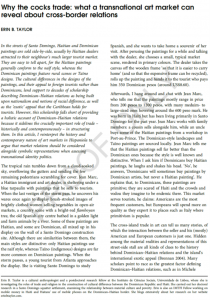

In the streets of Santo Domingo, Haitian and Dominican paintings are sold side-by-side, usually by Haitian dealers attracted to their neighbour’s much larger tourist market. They are easy to tell apart, for the Haitian paintings generally conform to the naïf style, whereas the Dominican paintings feature rural scenes or Taïno designs. The cultural differences in the designs of the paintings, and their appeal to foreign tourists rather than Dominicans, lend support to decades of scholarship describing Dominican–Haitian relations as being built upon nationalism and notions of racial difference, as well as the ‘exotic’ appeal that the Caribbean holds for tourists. However, this scholarship falls short of providing a holistic account of Dominican–Haitian relations because it sidelines the crucially important role of trade – historically and contemporaneously – in structuring them. In this article, I reinterpret the history and contemporary nature of art markets in Hispaniola to argue that market relations should be considered alongside symbolic representations when assessing transnational identity politics.









